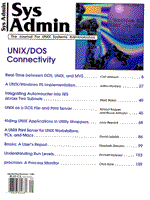
Sidebar: About DHCP
The DHCP protocol is set out in an Internet RFC, RFC 1531. This RFC describes in great detail how DHCP operates. I will provide merely a brief overview. DHCP resembles the BOOTP protocol, and is even capable of interacting with it. DHCP allows you to dynamically supply a client with configuration parameters, such as the IP address. For this purpose, DHCP is split into two functional parts. First, it allows a client to request its configuration information from a server. Second, it allows a server to allocate a network address to a client. This is based on a client/server model in which clients request information from a DHCP server. IP addresses can be allocated in three different ways. They can be allocated automatically, in which case the host is assigned a permanent IP address. This implies that there are enough IP addresses available to supply each (possible) host on the network. A second method is dynamic allocation, wherin a server has a number of IP addresses available for its clients and will allocate an address from its pool when a client requests one. This scheme works well when the number of IP addresses is limited and not all hosts are constantly connected to the network. The third way of allocating addresses is manually, that is, the network administrator assigns an address to a host, and DHCP is used as a way of getting the address to the node. For further information I recommend reading RFC 1531. It contains the complete specification of the protocol and the messages that are exchanged between the server and client.
|